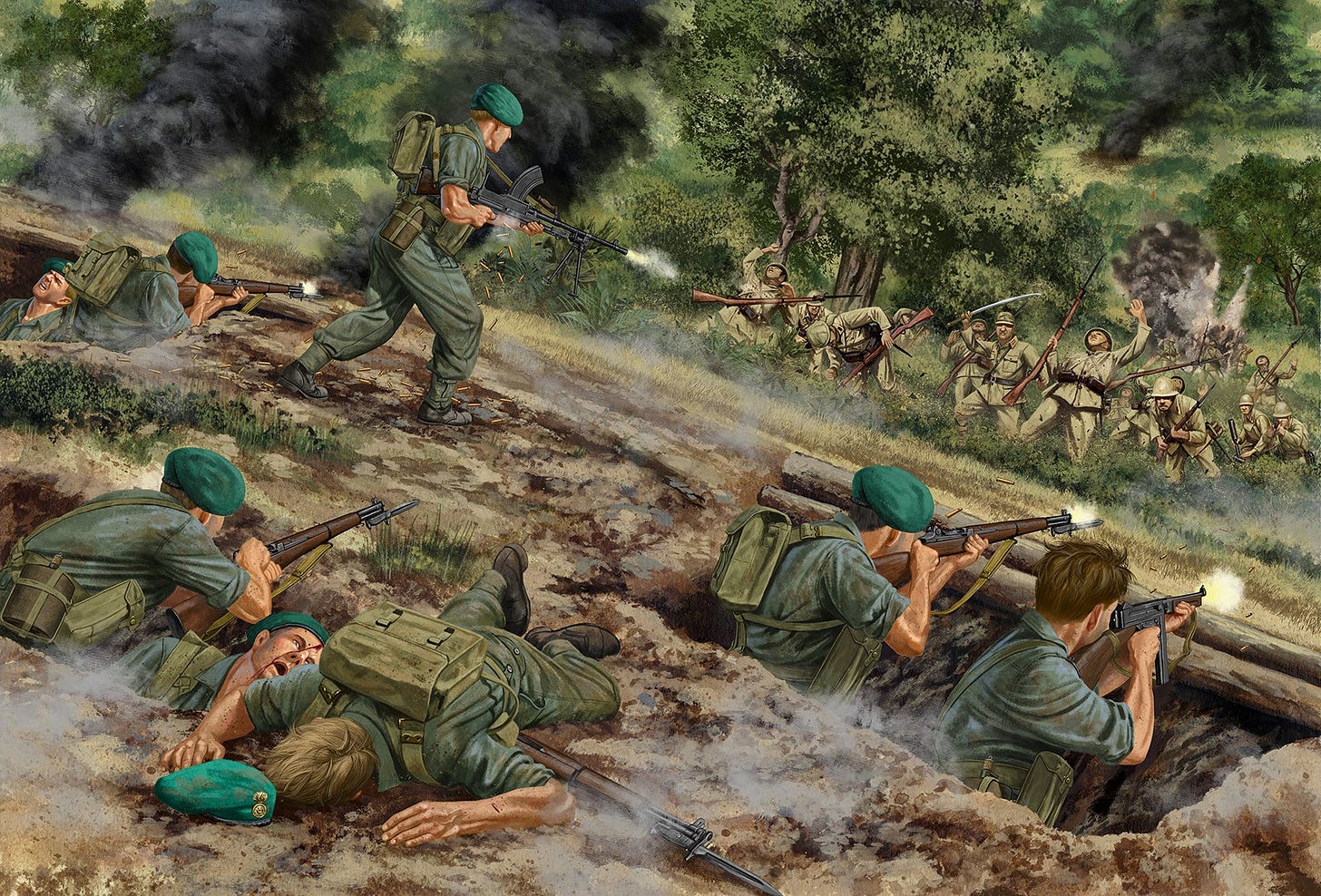What makes a VC?
Firing a 2-inch mortar from the hip: the extraordinary story of Lieutenant George Knowland, VC
Osprey are publishing a new book of mine in 2023 in their marvellous Campaign series about the Reconquest of Burma in 1945. They’ve commissioned some amazing new art work for the book, including one of the heroic action in which George Knowland was posthumously awarded a Victoria Cross in fighting for Hill 170 in Kangaw, Arakan.
As readers of my blog you are privileged to be the first to see Johnny Shumate’s stunning painting of this extraordinary action.
I have often been asked what it takes to be awarded a Victoria Cross. The citation for George Knowland, slightly amended below, says it all. Those of you who have been soldiers will understand the remarkable feat of firing a 2-inch mortar from the hip. Its not something I or anyone in the Small Arms School Corps would have ever have recommended:
On 31st January 1945, near Kangaw in Arakan Lieutenant George Knowland of No. 1 Commando (3 Commando Brigade) was commanding the forward platoon of a Troop positioned on the extreme north of a hill known as Hill 170 which was subjected to very heavy and repeated Japanese attacks throughout the day. Before the first attack started, Lieutenant Knowland's platoon was heavily mortared and machine gunned, yet he moved about among his men keeping them alert and encouraging them, though under fire himself at the time. When the enemy, some 300 strong in all, made their first assault they concentrated all their effects on his platoon of 24 men but in spite of the ferocity of the attack, he moved about from trench to trench distributing ammunition, and firing his rifle and throwing grenades at the enemy, often from completely exposed positions. Later, when the crew of one of his forward Bren guns had all been wounded, he sent back to troop headquarters for another crew and ran forward to man the gun himself until they arrived. The enemy was then less than 10 yards from him in dead ground down the hill so in order to get a better field of fire, he stood on top of the trench, firing the light machine gun from his hip and successfully keeping them at a distance until a Medical Orderly had dressed and evacuated the wounded men behind him. The new Bren Gun team also became casualties on the way up and Lieutenant Knowland continued to fire the gun until another team took over. Later, when a fresh attack came in he took over a 2-inch Mortar and in spite of heavy fire and the closeness of the enemy, he stood up in the open to face them, firing the mortar from his hip and killing six of them with his first bomb. When all bombs were expended he went back through heavy grenade, mortar and machine gun fire to get more, which he fired in the same way from the open in front of his platoon positions. When those bombs were finished he went back to his own trench and still standing up fired his rifle at them. Being hard pressed and with the enemy closing in on him from only 10 yards away, he had no time to re-charge his magazine. Snatching up the Tommy gun of a casualty, he sprayed the enemy and was mortally wounded stemming this assault, though not before he had killed and wounded many of the enemy. Such was the inspiration of his magnificent heroism, that, though fourteen out of twenty-four of his platoon became casualties at an early stage, and six of his positions were over-run by the enemy, his men held on through twelve hours of continuous and fierce fighting until reinforcements arrived. If this northern end of the hill had fallen the rest of the hill would have been endangered, the beach-head dominated by the enemy and other units farther inland cut off from their source of supplies. As it was, the final successful counter-attack was later launched from the vital ground which Lieutenant Knowland had taken such a gallant part in holding.
Knowland, sadly, died of his wounds. His body is buried in Taukkyan War Cemetery, Yangon, one of seven recipients of the Victoria Cross interred there.
Roderick Bailey’s excellent book Forgotten Voices of the Victoria Cross has some more first hand accounts of this action.
As a postscript, his VC was received by his widow, Ruby, who passed it on to his father, who proudly displayed it in his pub in Finsbury. In 1958 it was stolen and its current whereabouts is sadly unknown.
My good friend Steve Snelling will be giving an online talk to the Kohima Educational Trust on the action at Hill 170 in March 2023. You can stay in touch with these events here.
If you want to know more about the wider context of this battle, I can recommend a recent book on the subject…






Christ, what a hero and what sort of lowlife would steal his VC scum
These people, all of them really, a truly remarkable.